Pergamon – Visiting Turkey’s Roman Stronghold
This is the fourth day of the Adventures Abroad trip that Alison and I took to Turkey in October, 2021. Yesterday we left Istanbul and toured the battlefields of Gallipoli and then visited the almost mythical site of ancient Troy. Today we are headed to Pergamon another ancient city. Unlike Troy which has nine layers spread over thousands of years, Pergamon is a very well preserved Greco-Roman site that sits on a mighty acropolis high above the Anatolian plain. It once housed one of the greatest of the ancient libraries, second only to Alexandria and was one the most important cities in the entire Roman Empire. It is a place I have wanted to visit since first reading about as a boy. Please join our group as we visit this UNESCO World Heritage Site.
Here is a map showing our route in blue from Canakkale where we spent the night to the small city of Bergama above which are the ruins of Pergamon.
We get an early start and head south on Turkish highway E87 which is very scenic with numerous signs pointing the way to many of the ancient sites that are found both on the coast and inland. One could spend months in this part of Turkey just exploring these lesser visited sites some of which like Assos are proposed for UNESCO World Heritage Sites designation like Troy and Pergamon.
Each morning we stop for a coffee and bathroom break around 10:00. Just down the road from the place we have stopped is this very common and clever sight you see all over Turkey. Yes it’s a fake police car, but you can’t tell that from a distance. Occasionally there will be a real one parked just this way so it discourages speeding without having to employ a lot of resources.
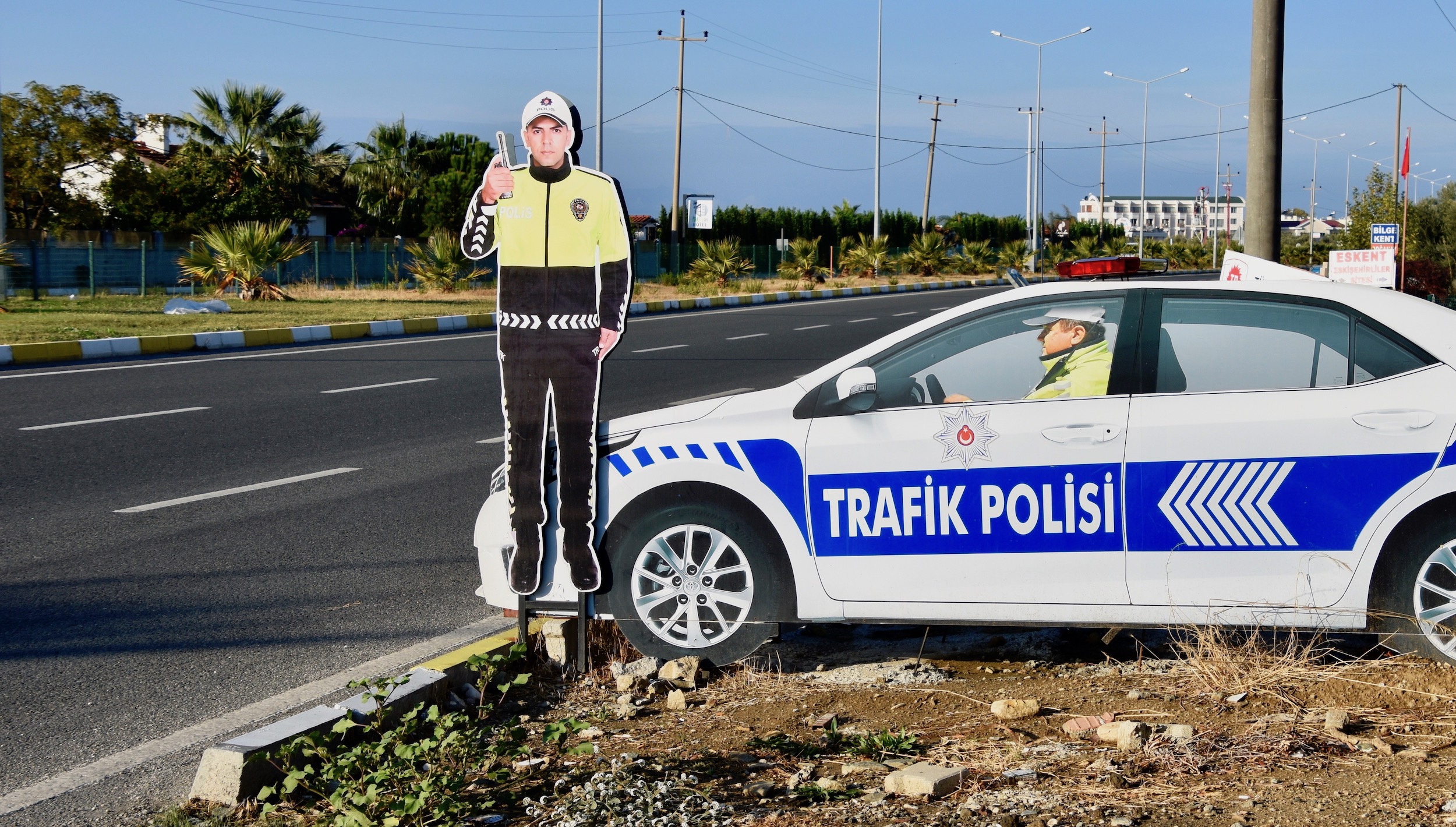
For a good portion of this route there are views of the Greek island of Lesbos, the third largest in the country which in places lies just a few miles off the Turkish coast. At Ayvalik Ahmet our driver turns inland and we ascend rapidly through an area known for its pine nut production as well as grapes.
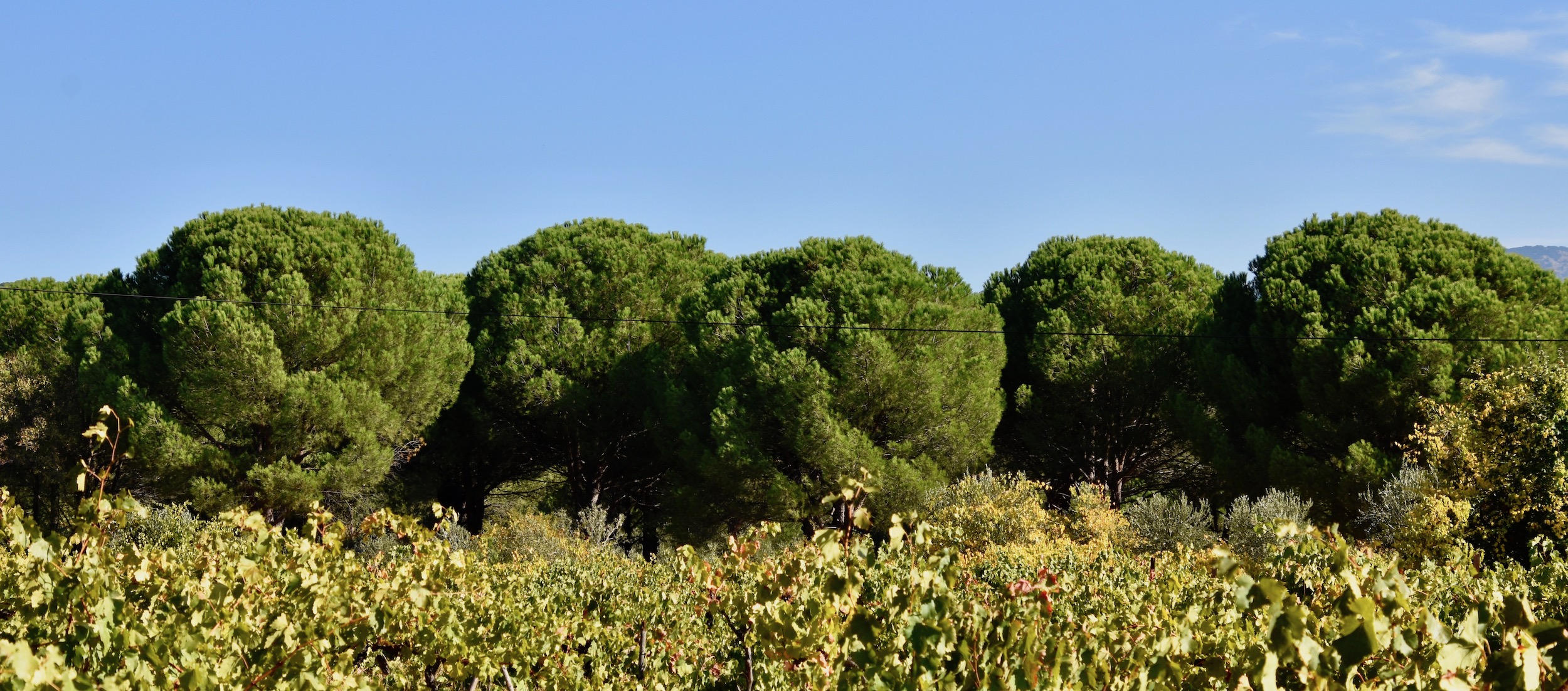
Yasemin, our guide, asks if we want to stop at a road side stand to purchase some pine nuts and everyone says yes. As you can see there are a variety of nuts, fruit and honey for sale.
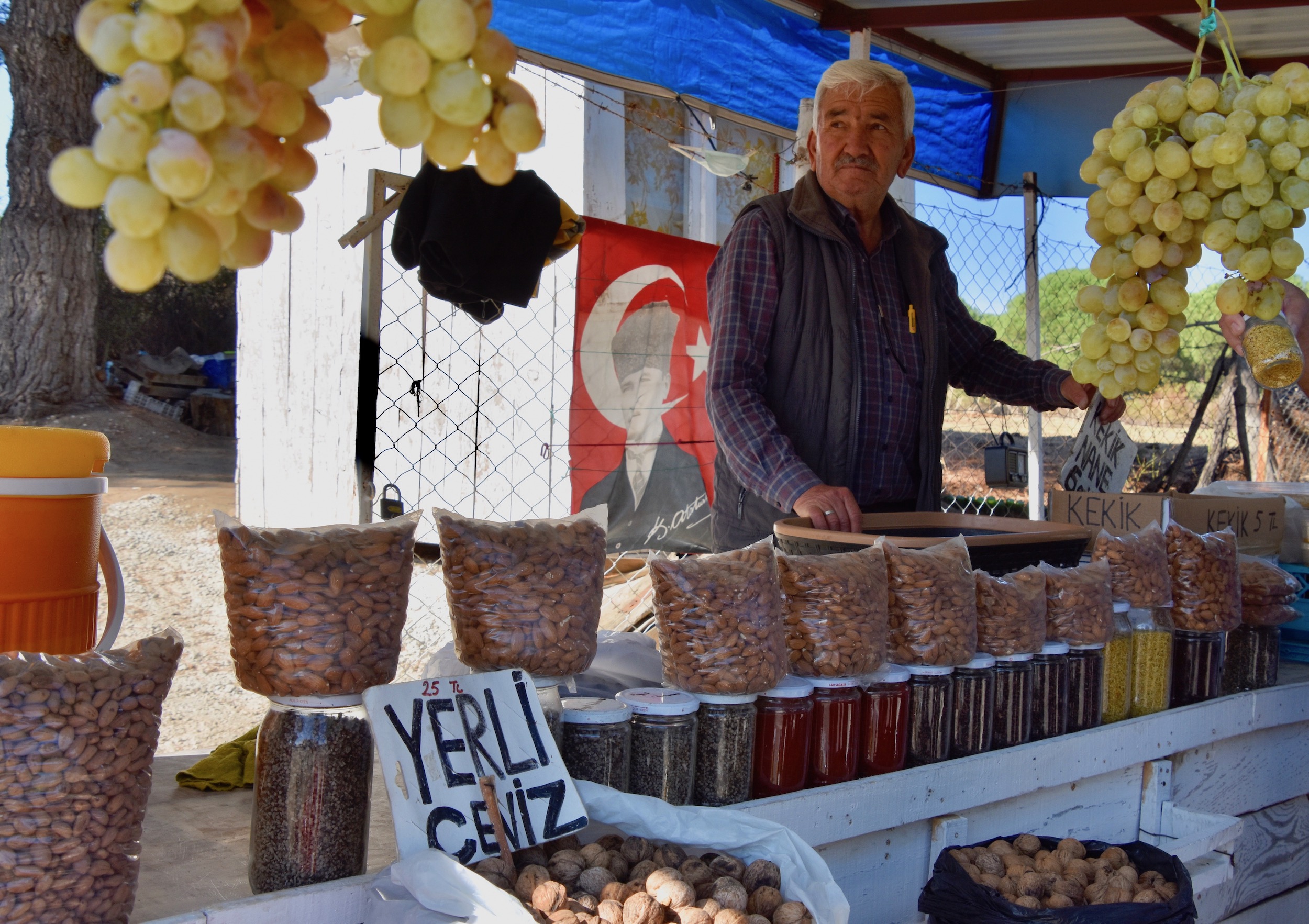
We arrive in the small tree lined town of Bergama just in time for lunch.
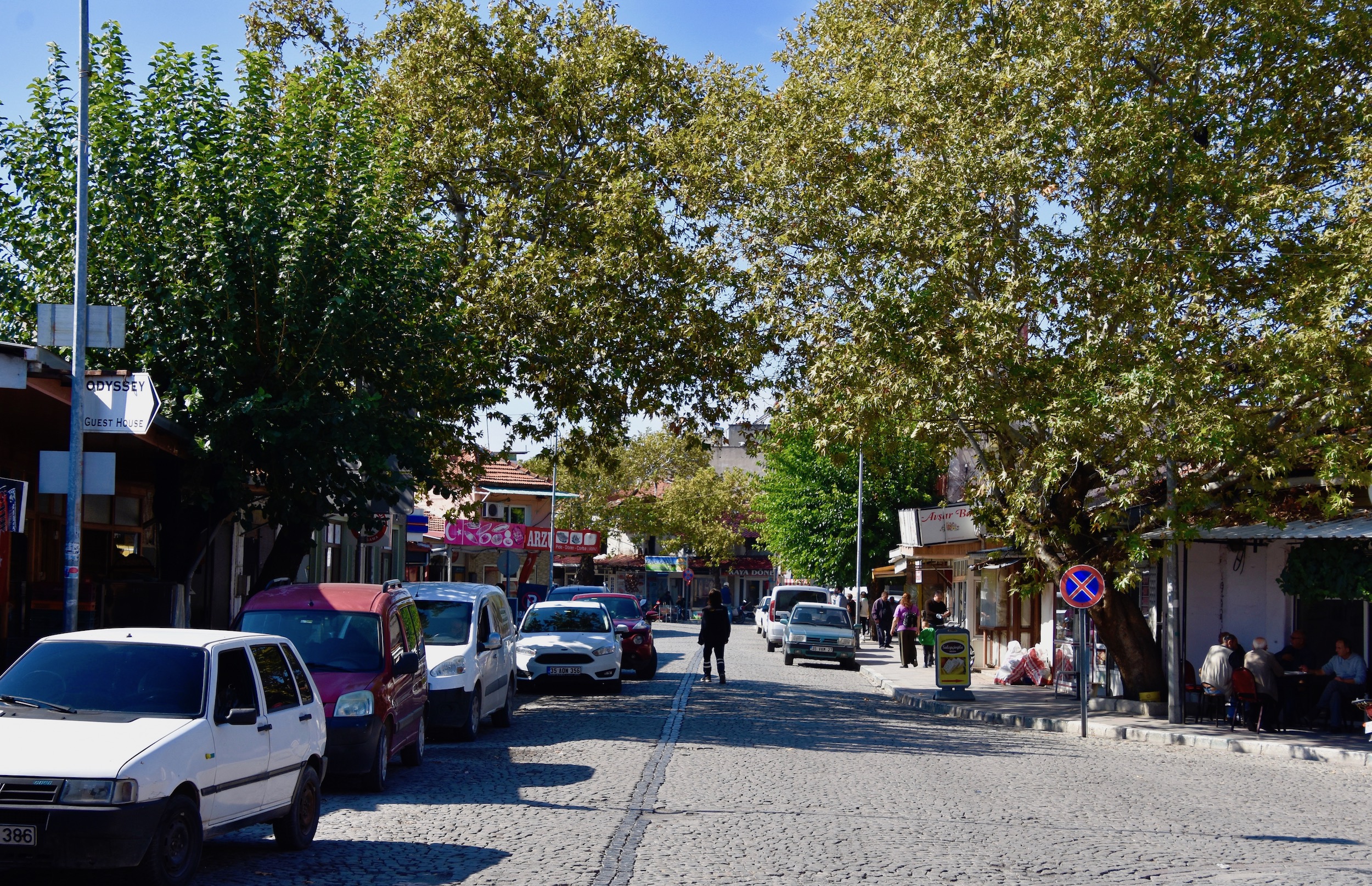
These lunches are on our own dime and Yasemin gives a number of options of places to eat, but Alison and I pretty well always opt for the local specialties. Most Turkish restaurants have some really good hot soups, stews and casseroles to choose from. You just point to what looks good and they dole it out, usually in very generous proportions at very reasonable prices. This was my lunch in Bergama. Delicious.
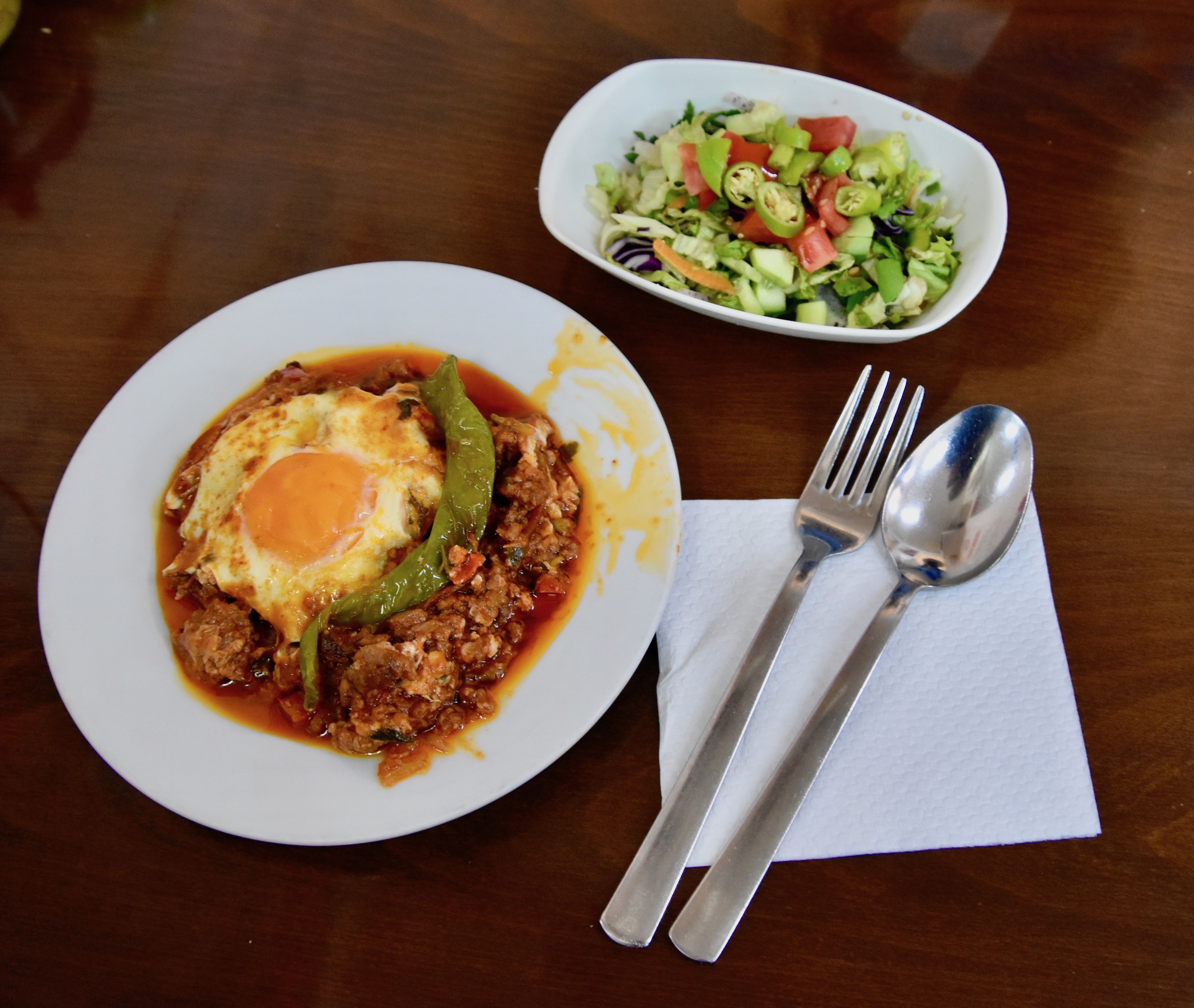
On the way into Bergama we had a glimpse of Pergamon high above the town. Now it was time to go up there, but first a little history.
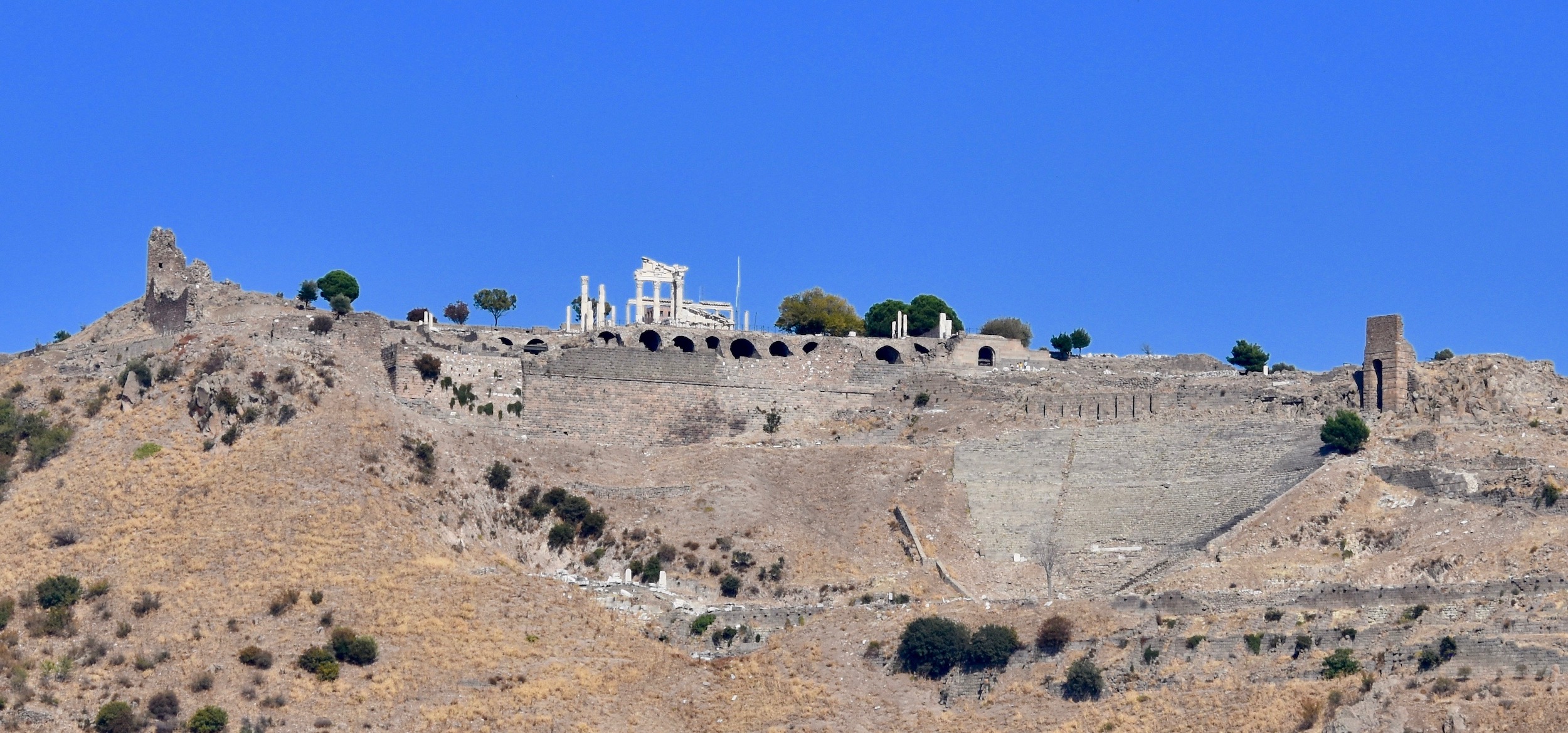
History of Pergamon
The first mention of Pergamon in written history is in Xenophon’s Anabasis which is one of the most remarkable texts from classical Greek literature. It relates the story of the 10,000. These were Greek mercenaries led by Xenophon who were hired by Cyrus the Younger to help him take the throne of Persia from his brother Artaxerxes II. While the Greeks won the necessary battles, Cyrus up and died leaving the Greeks stranded a thousand miles from home. Eventually they made their way to Pergamon and the safety of the Greek world. This is a map of the march of the 10,000 which shows many of the kingdoms that we will visit on this tour including Lydia, Caria, Lycia, Pamphylia and Cappadocia.
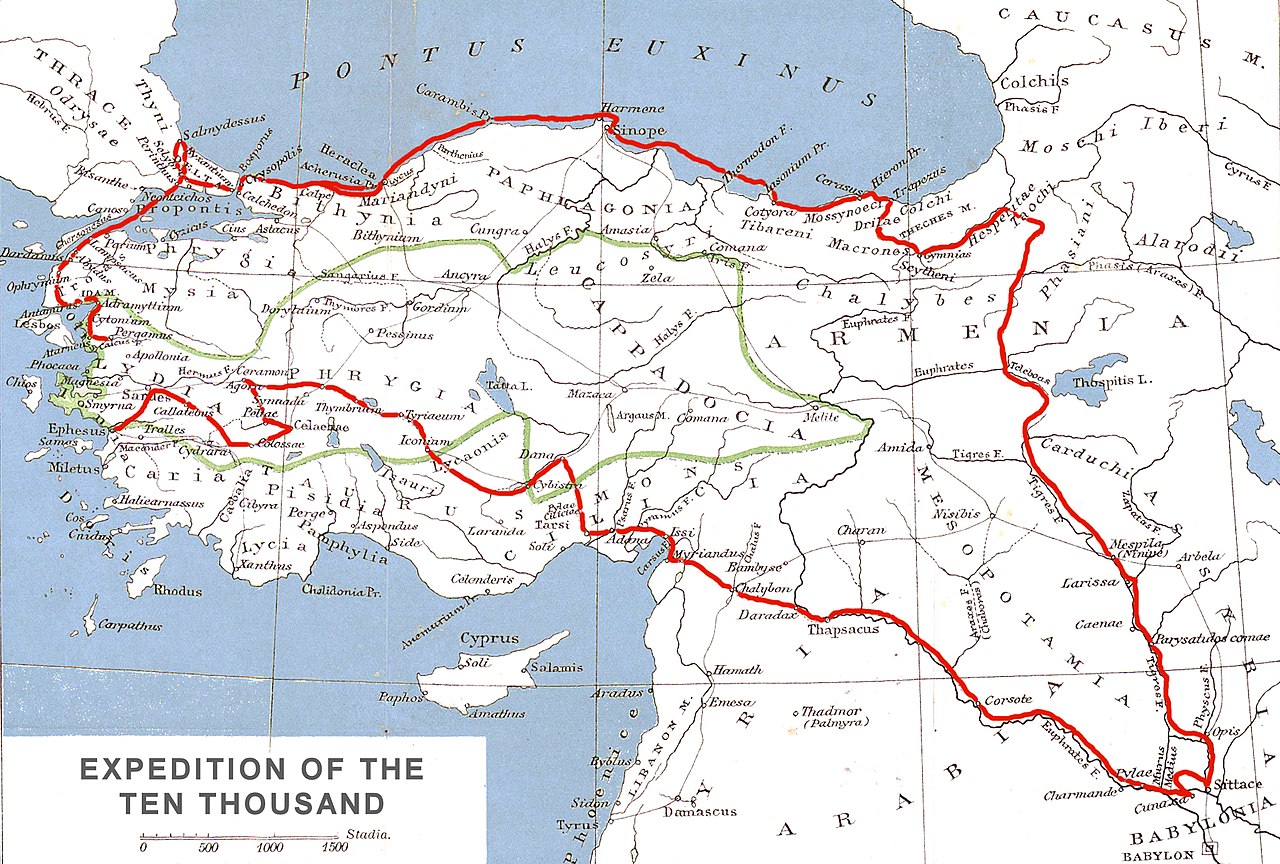
Pergamon really came into its own in the Hellenistic period that followed the death of Alexander the Great and the division of his empire by his generals. The Kingdom of Pergamon was created by Philetaerus, a rebellious lieutenant of one these generals who founded the Attalid dynasty that ruled successfully for 150 years. The Attalids were noteworthy for their numerous wars with the Galatians who were the same people who were eventually called Gauls. I doubt many French people know that their antecedents actually came from Asia Minor and it was their defeats by the Attalids that led to the start of their migrations west. The Attalids were noteworthy for their works of sculpture of which The Dying Gaul is the most famous. Instead of depicting the defeated enemy with disdain, this school of sculpture portrayed the Gauls in a sympathetic and realistic manner. The original was believed to be cast in bronze and is long lost, but this marble replica now in the Capitoline Museum in Rome is considered one of the great sculptures of antiquity and there are many copies around the world.
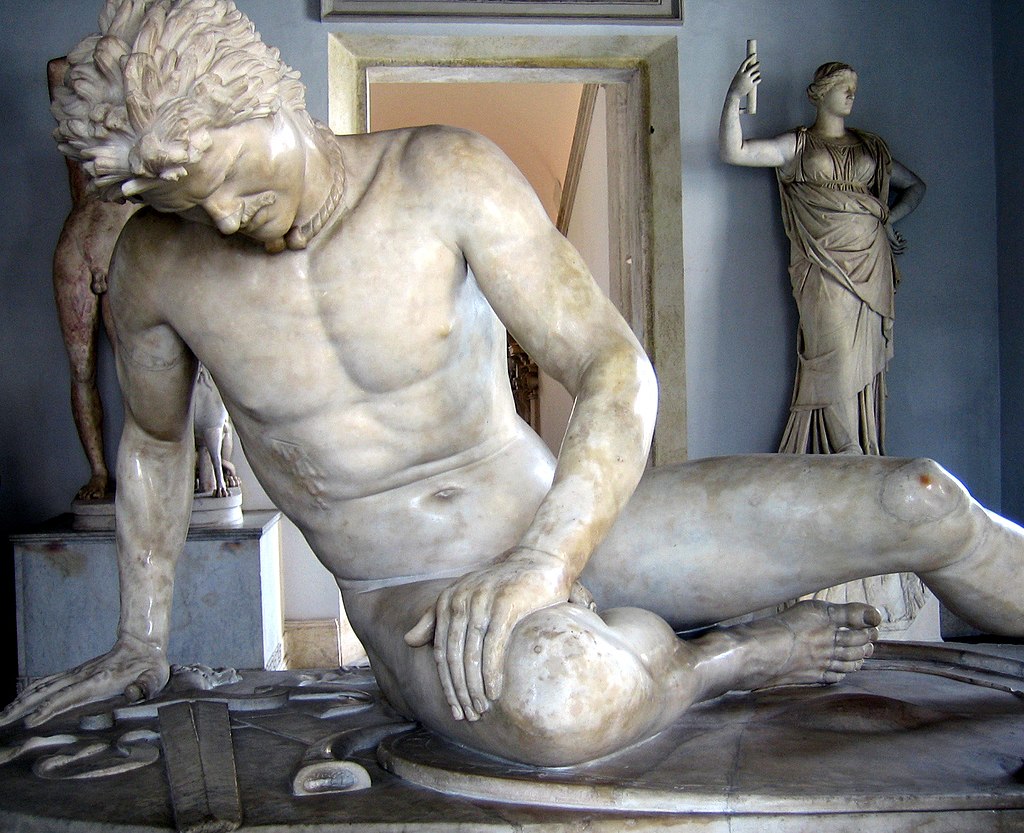
The Attalid dynasty ended in a most unusual way when King Attalus III died without an heir and bequeathed his kingdom to the Roman Empire with whom the Attalids had had good relations for many years. Under the Romans Pergamon became the capital of the province of Asia and grew to be one of the largest cities in the Roman Empire with a population of over 200,000. Most of what we will see today dates from the Roman era. This is what Pergamon is believed to have looked like at its height. Awe inspiring for sure.
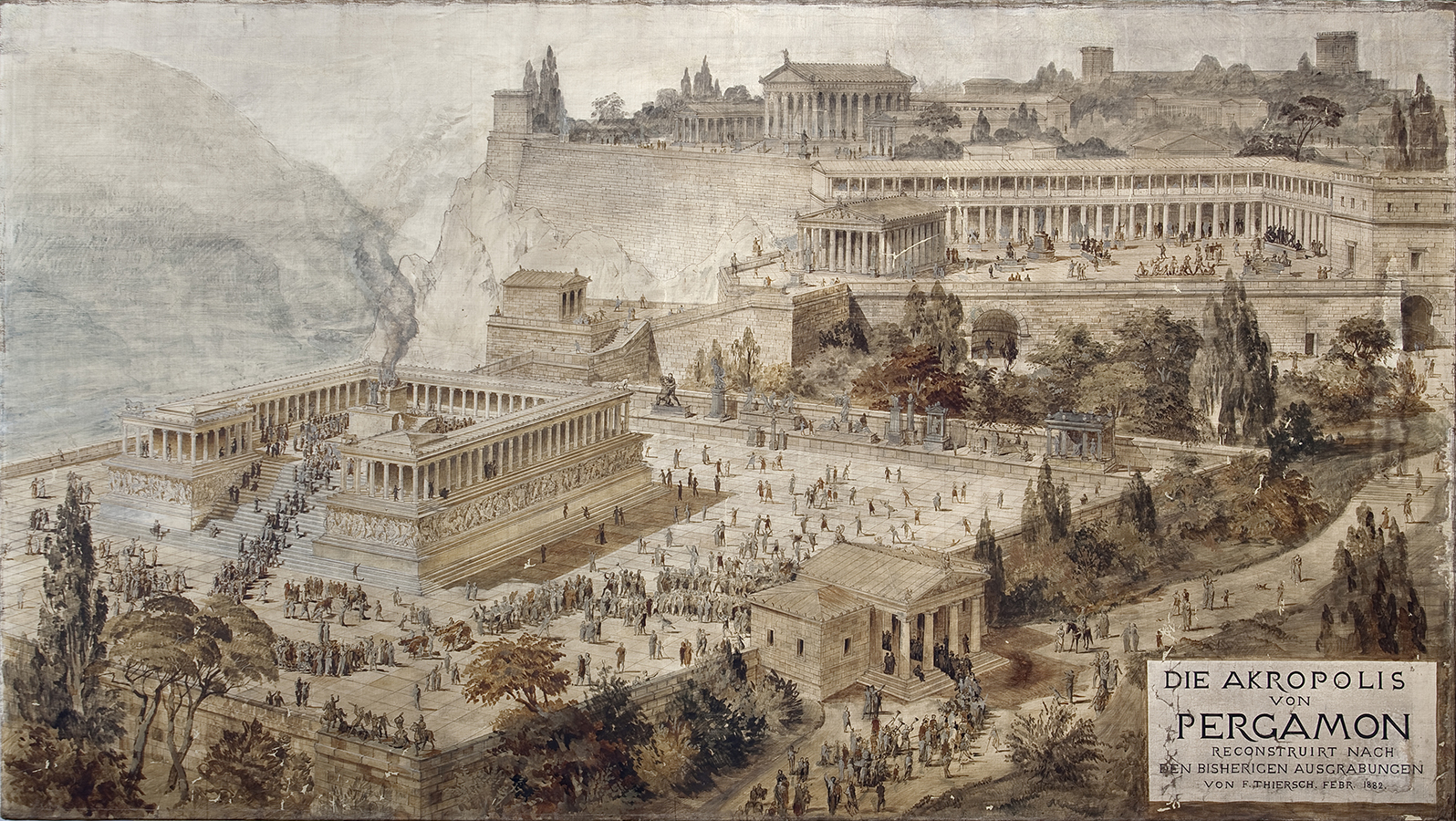
During the Byzantine period the city went into a slow decline, suffering a major earthquake and a Gothic sack. By the time the Ottomans took over it was a city of ruins.
In 2014 Pergamon was designated as a UNESCO World Heritage Site with this brief description.
Pergamon was founded in the 3rd century BC as the capital of the Attalid dynasty. Located in the Aegean Region, the heart of the Antique World, and at the crossroads between Europe and the Middle East, it became an important cultural, scientific and political centre. Creation of the capital on top of Kale Hill set the scene for the city. High steep sloping terrain and the Bakırçay Plain were integrated into the urban plan. The exceptional composition of monuments includes the extremely steep theatre, the lengthy stoa, a three-terraced Gymnasium, the Great Altar of Pergamon, the tumuli, pressured water pipelines, the city walls, and the Kybele Sanctuary which was perfectly aligned with Kale Hill. As the Attalid capital, Pergamon was the protector of cities in the Hellenistic Period. It had political and artistic power and built up a very intense relationship with its contemporary civilisations. The dynasty founded one of the largest libraries in Pergamon, and the rivalry between three Hellenistic dynasties caused the Attalid Dynasty to create the famous sculpture school.
Visiting Pergamon Today
One of the most interesting things about visiting Pergamon is how you get there. In 2010 an eight passenger gondola lift opened which whisks visitors from Bergama to the Acropolis in four minutes. I found this combination of the newest technology to visit an ancient site interesting to say the least.
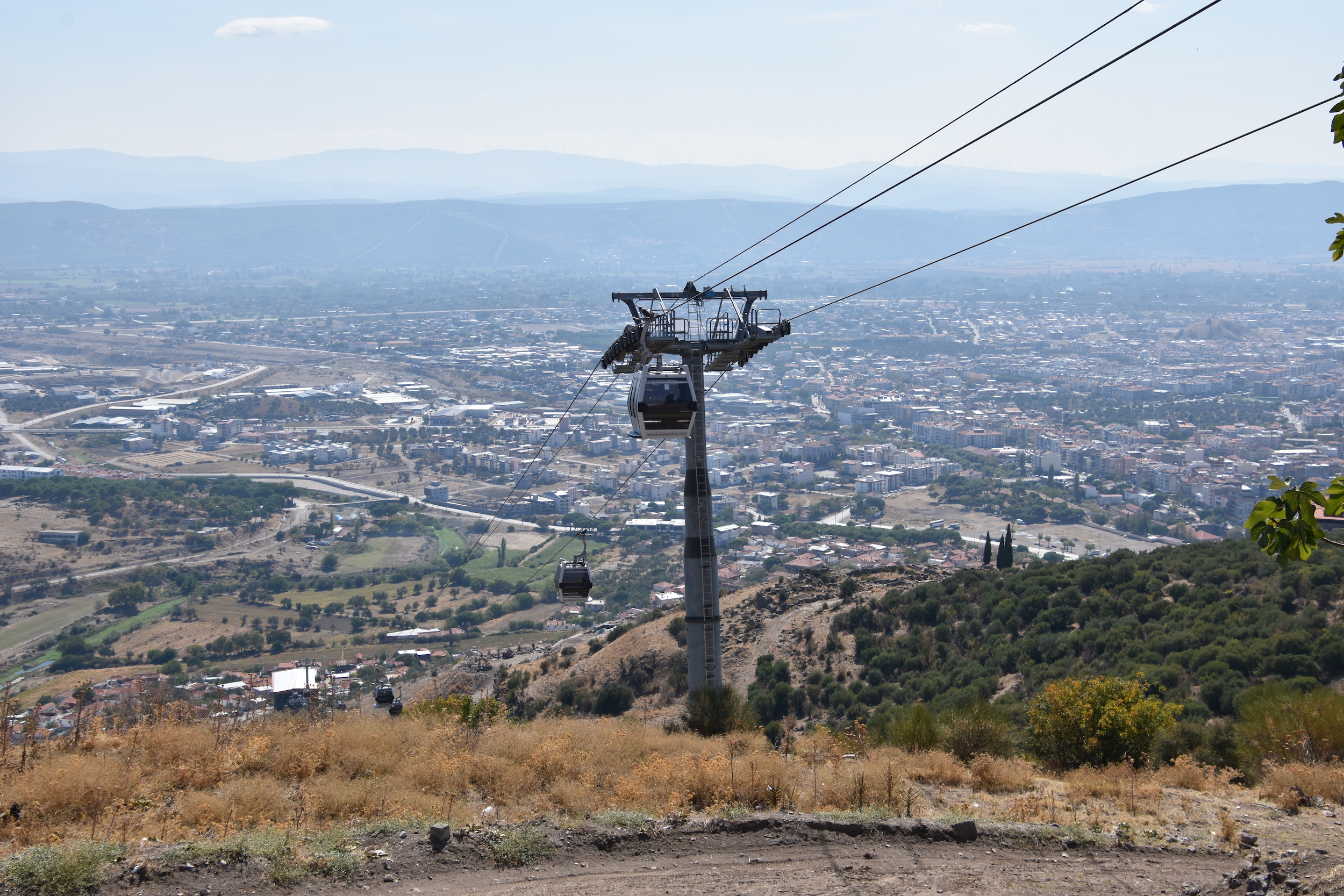
Here is a number of our group arriving at the acropolis.
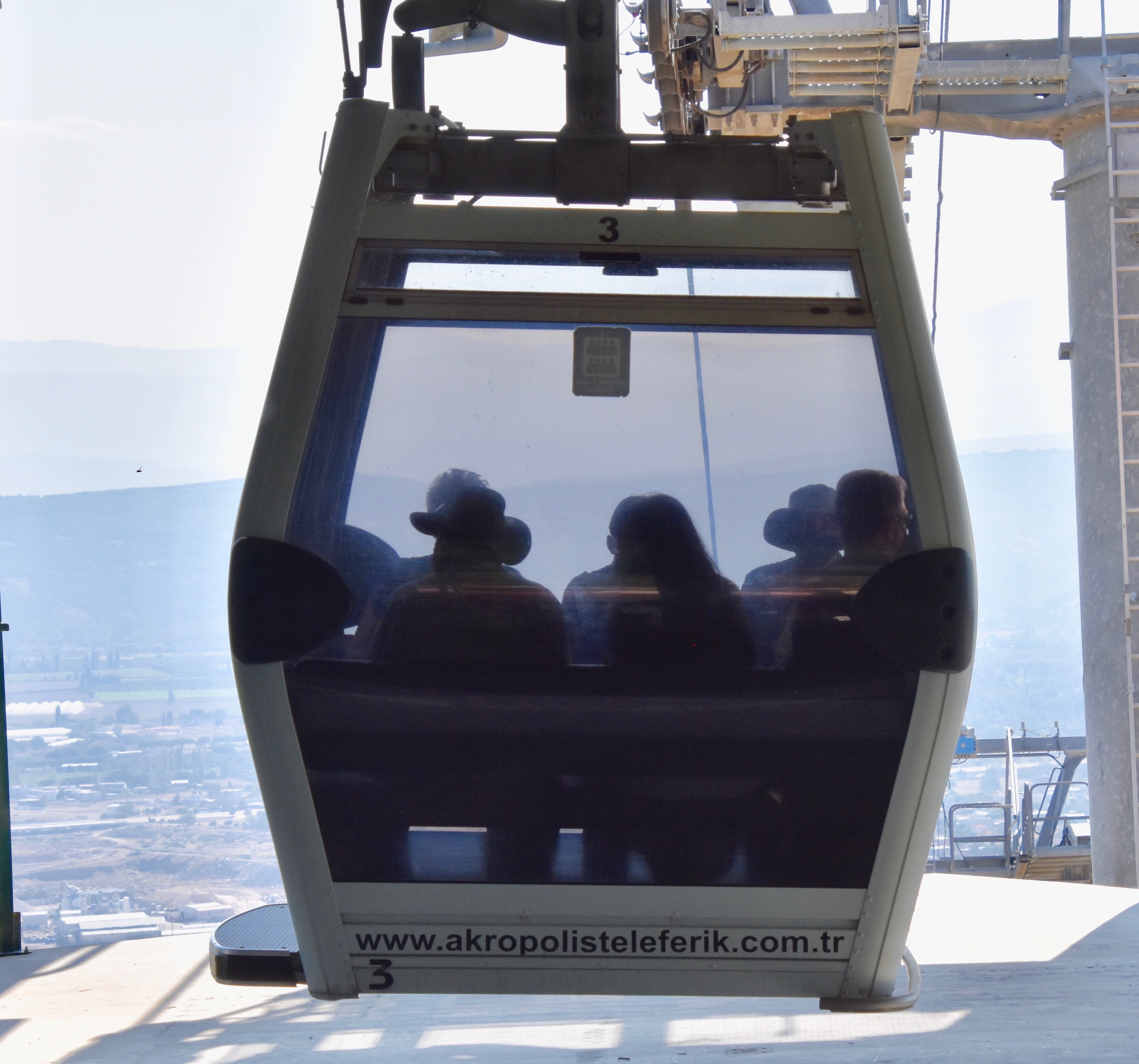
Just as at Troy and Gallipoli, we were virtually the only tourists at Pergamon on this warm autumn afternoon. Before starting our tour we had a bathroom break and I couldn’t help but wonder at the symbolism of the broken spear indicating the men’s washroom. Notice the evil eye protector as well. Wouldn’t want your private parts to get cursed.
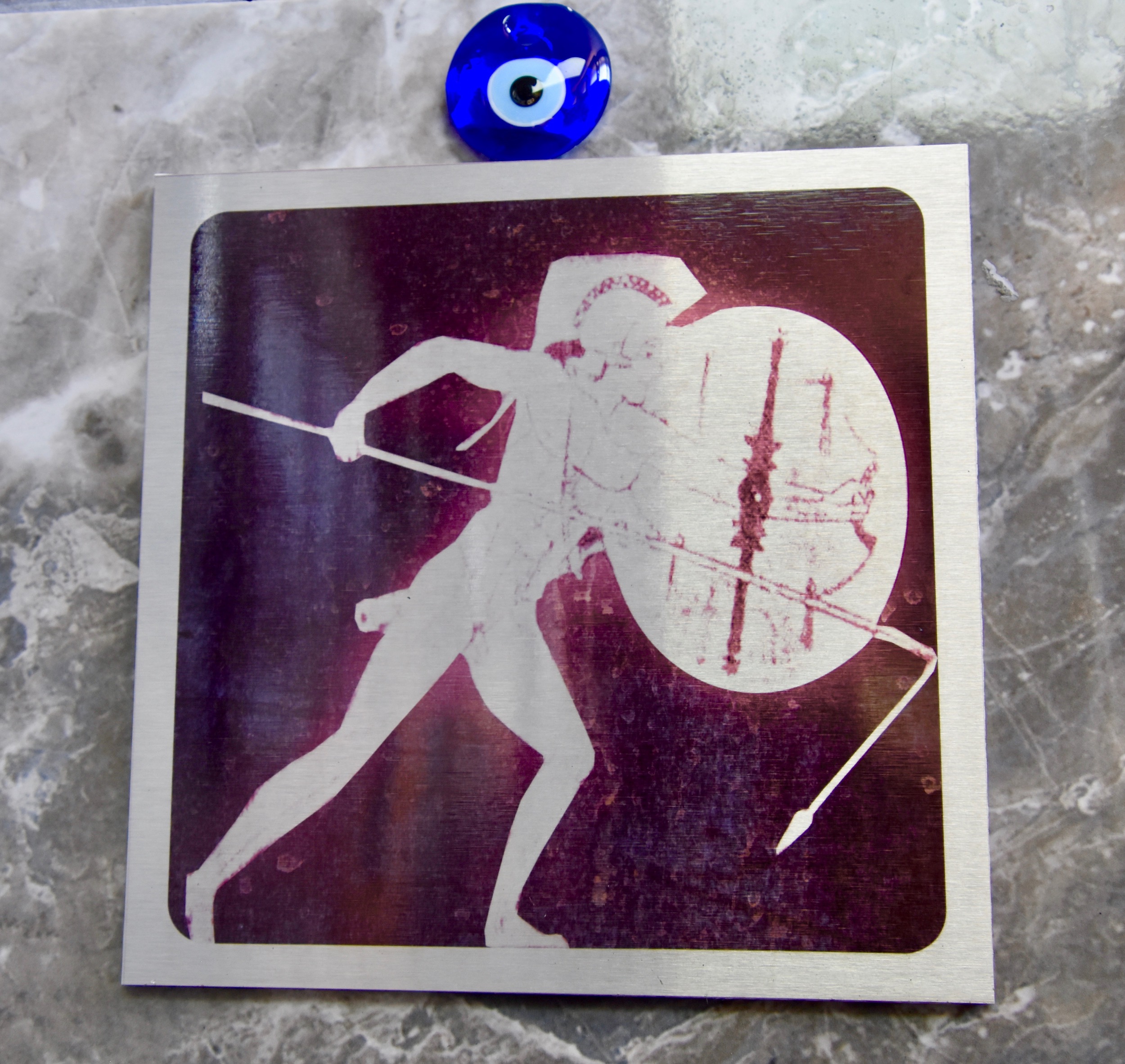
After viewing a model of the acropolis our tour begins outside the remnants of the walls that once encircled the acropolis. Note the many types and differing sizes of the rocks used in the construction of these walls.
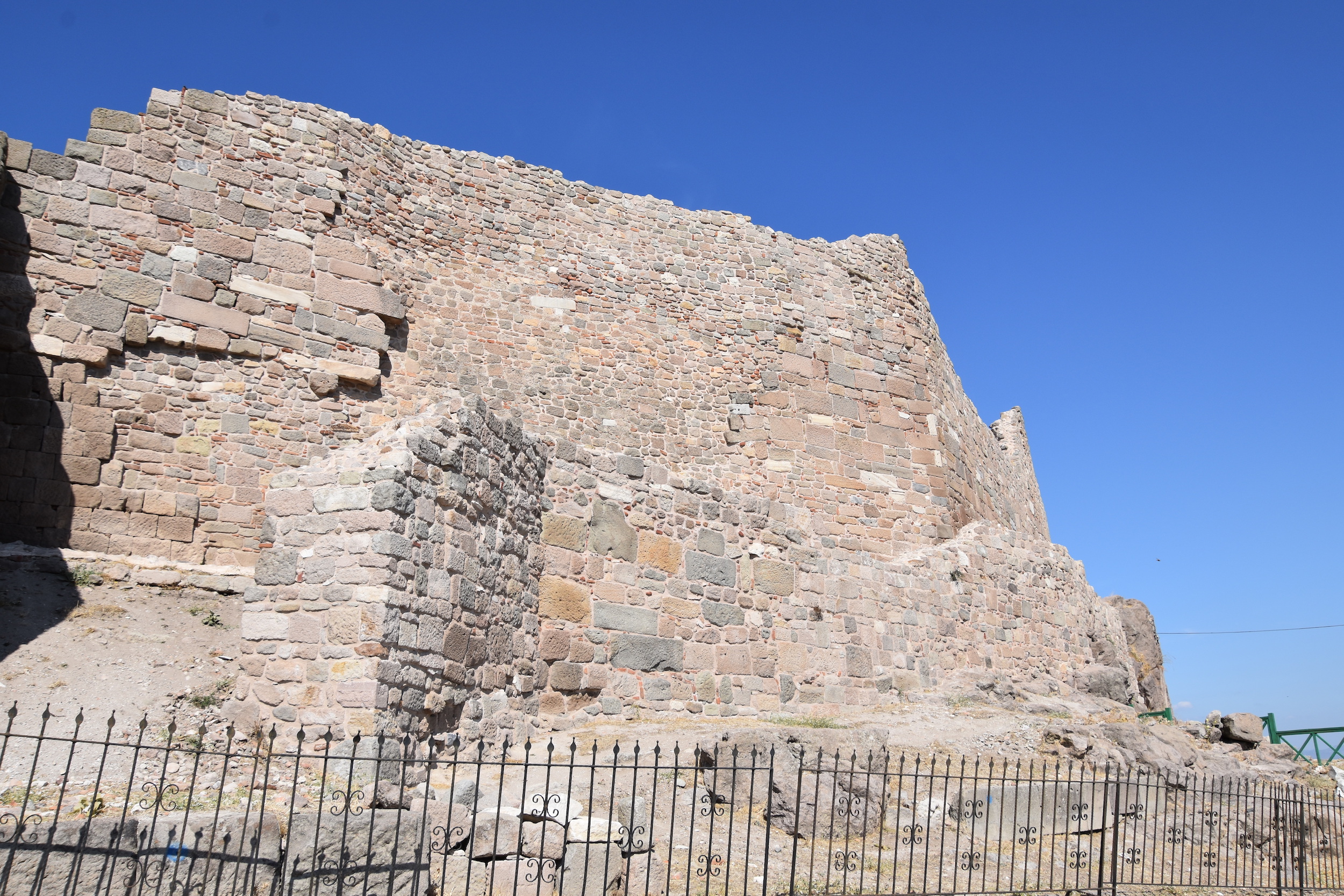
Entering the acropolis proper we come across the Temple of Athena which is the oldest structure in Pergamon dating from at least the 4th century BC if not earlier. It is a Doric temple and is believed to be the oldest Greek temple in Anatolia. The Greeks who migrated to this area and founded the city very much wanted to emulate the great city of Athens and thus chose Athena as their major goddess. They hoped to create an acropolis that would rival that of her native namesake city.
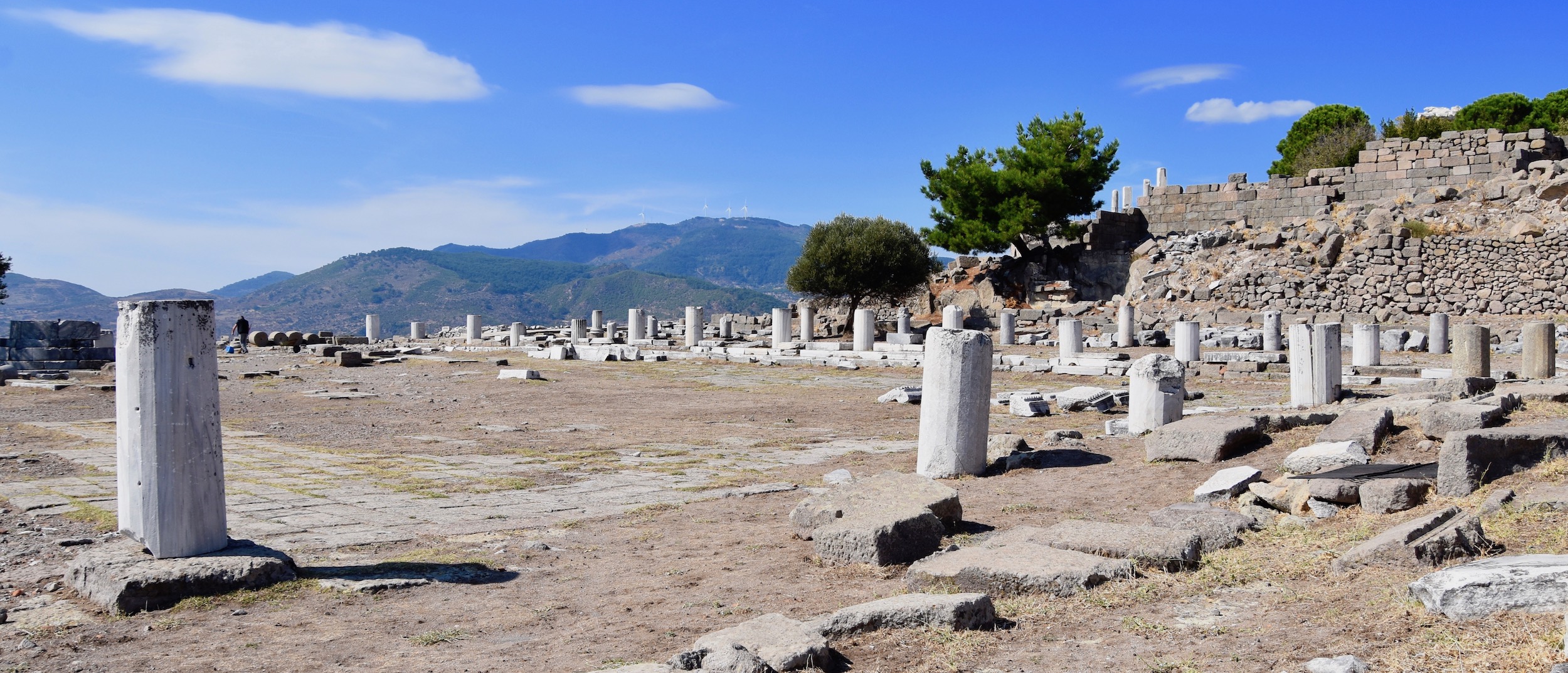
While there is not much remaining of the temple at Pergamon, there was a lot more before German archaeologists arrived in the 1860’s and systematically removed the best preserved remains including the propylon of this temple that was erected by Attalid ruler Eumenes II in the 2nd century BC. You can see it today at the Pergamon Museum in Berlin. This is the same museum that I wrote about in my post on the Ancient Orient Museum in Istanbul that also has on display most of the original Ishtar Gate from Baghdad.

This is what the temple would have looked like when it was still standing, from the VoyageTurkey.Net website.
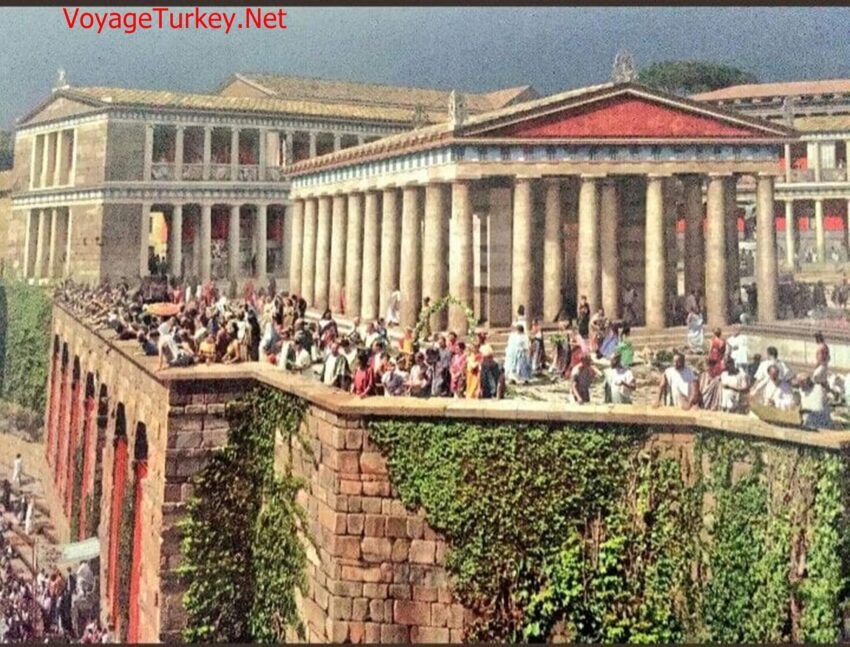
The large structure behind the temple is believed to have been the site of the great library of Pergamon which once held over 200,000 scrolls and rivalled that of Alexandria in importance. The scrolls in Pergamon were made of parchment which was made in the city as an alternative to the papyrus scrolls found at Alexandria. The name Pergamon actually derives from the word parchment.
This nondescript pile of rocks is where that famous statue of The Dying Gaul once was on display inside the Temple of Athena.
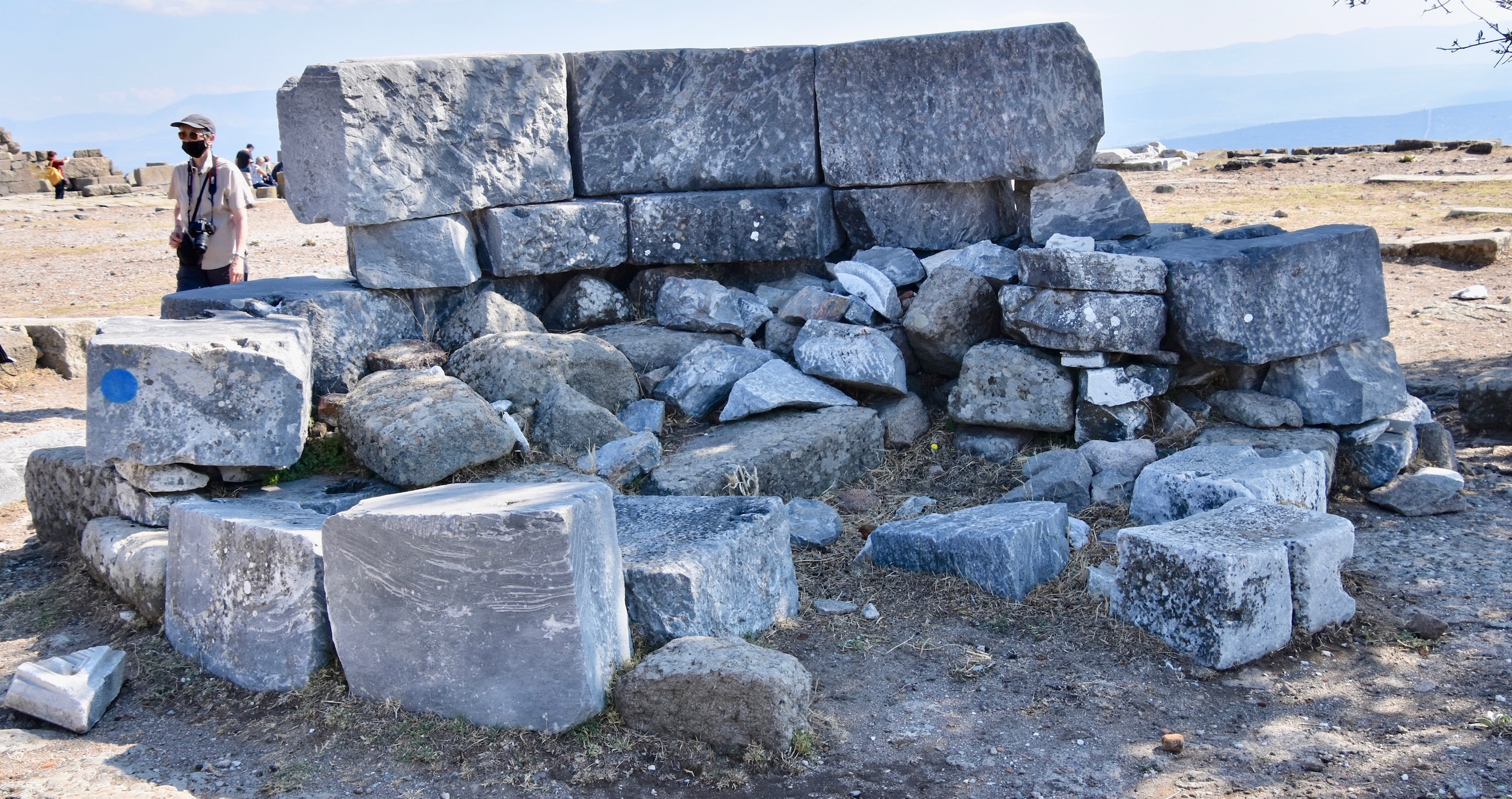
This is the outer portal of the Temple of Athena.
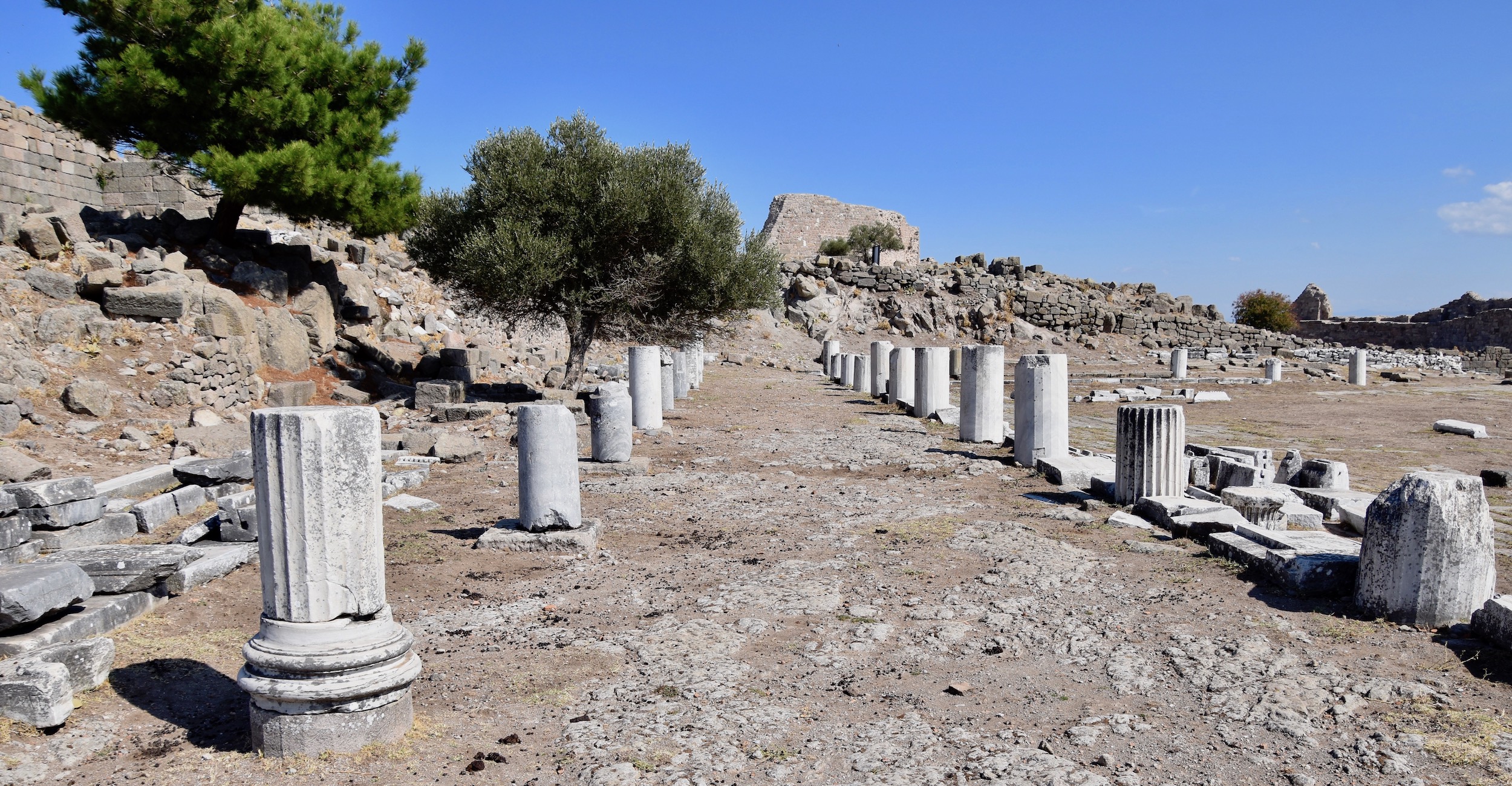
From the Temple of Athena our guide Yasemin led us toward the Trajaneum which is on the highest point of the acropolis.
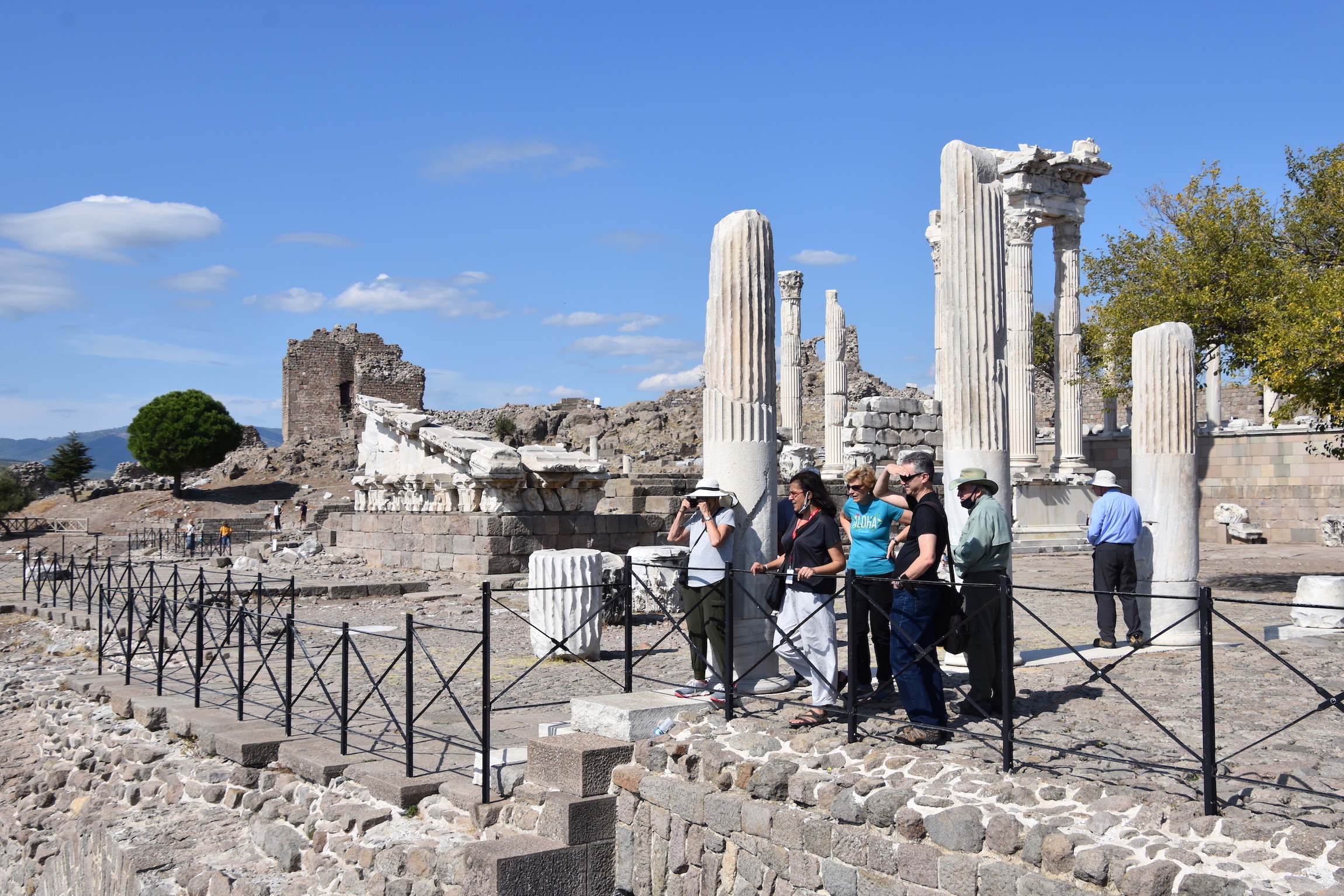
This is our group looking out at this amazing view from the acropolis. Those are the remains of the aqueduct that brought water from the nearby mountains to the Selinus valley below where most of the residents of ancient Pergamon resided.
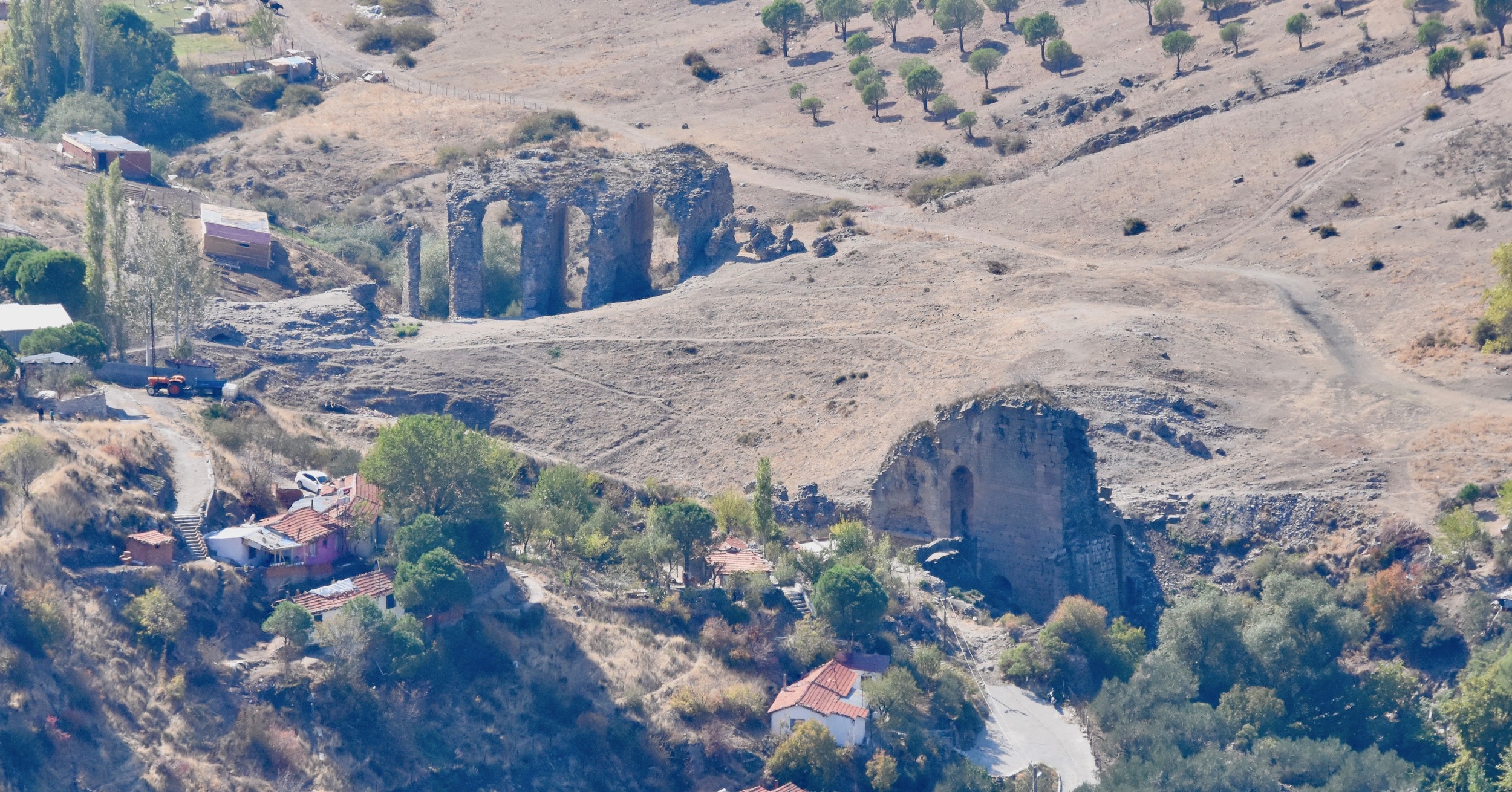
The Trajaneum was started by the Roman emperor Trajan and completed by his successor Hadrian. It is actually the only Roman era structure in Pergamon and makes a magnificent ruin.
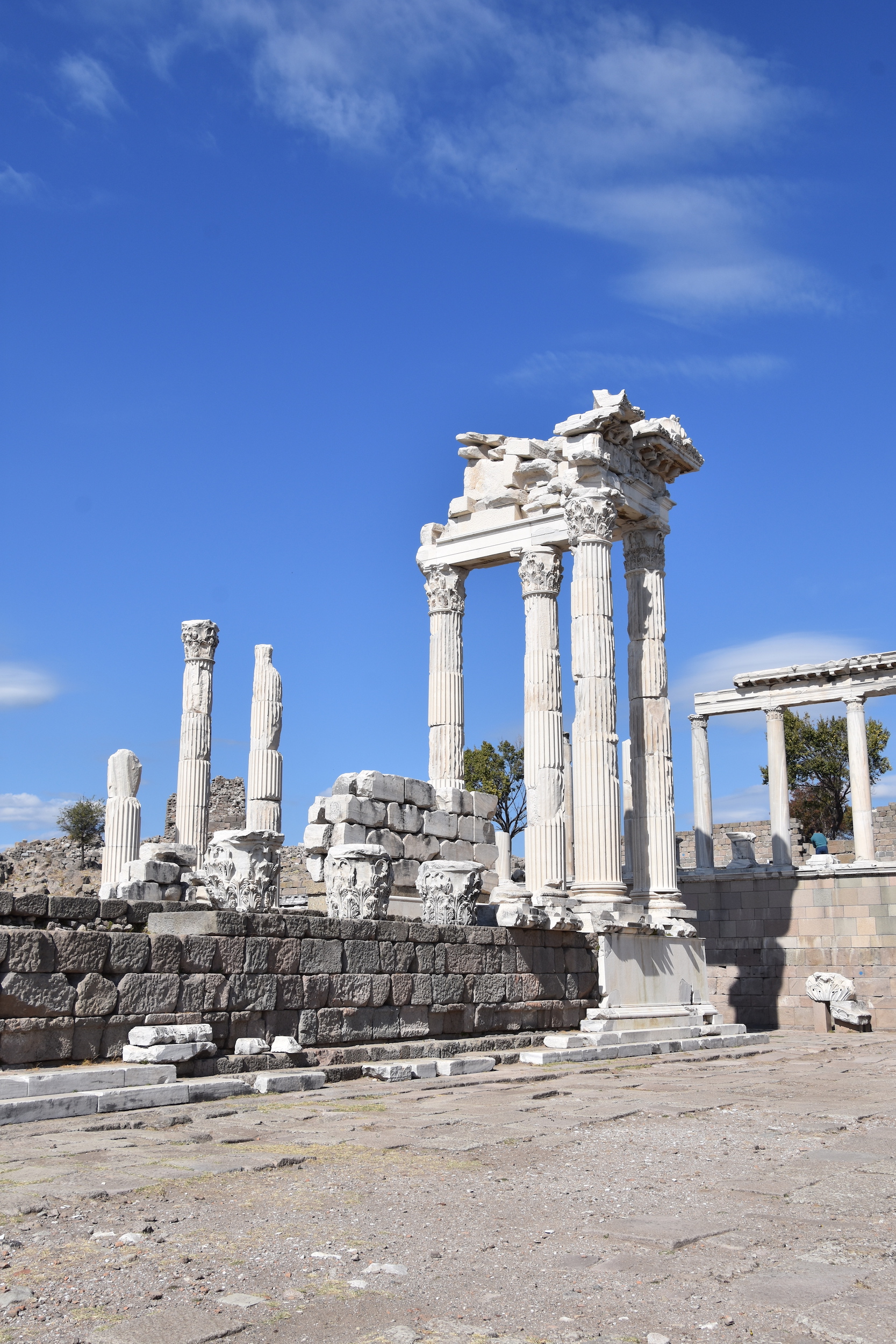
It was dedicated to Zeus Philios as well as Trajan. By the 2nd century AD the Roman emperors were considered to be gods and so this was a place to worship not only the greatest of the gods, but their living embodiments as well.
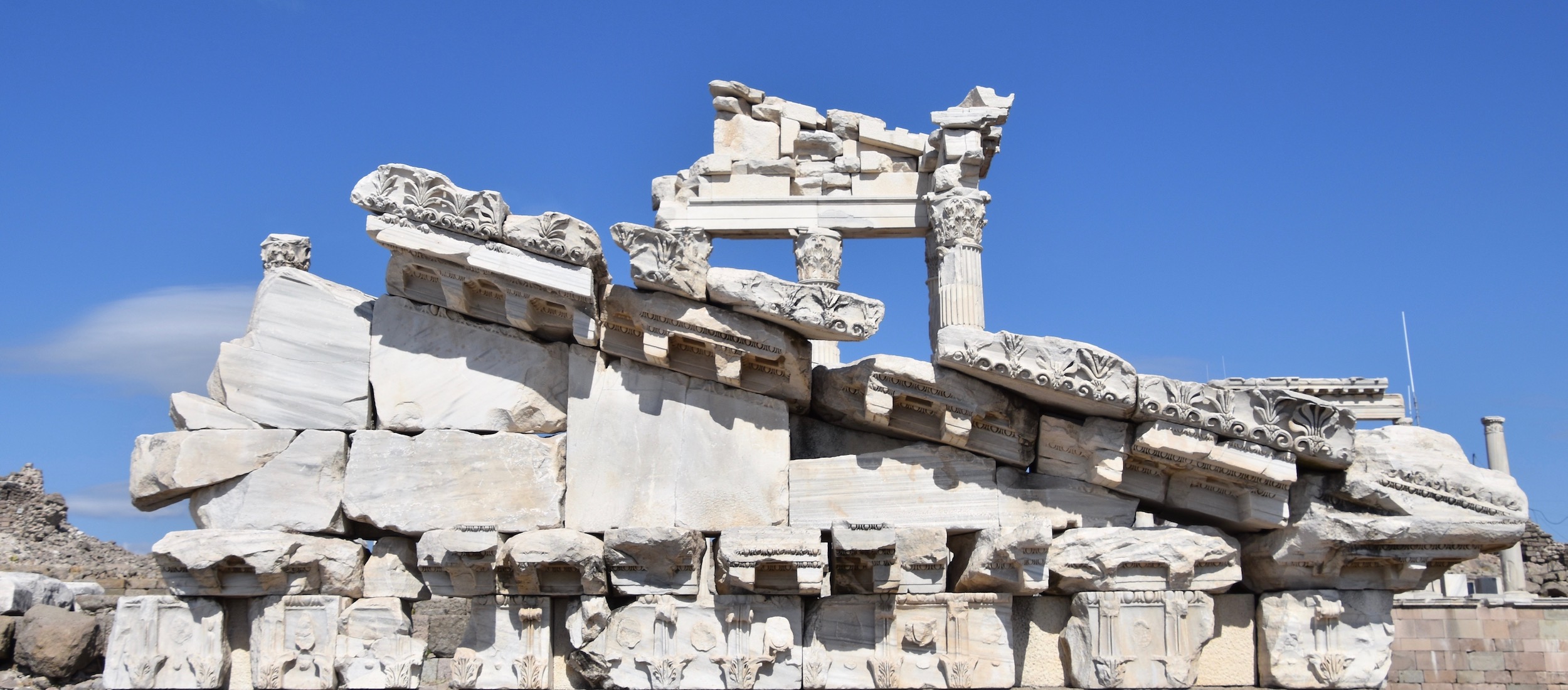
This is looking down to the Selinus valley from the Trajaneum. As you can appreciate from this photo, the acropolis of Pergamon is far higher than the more famous one in Athens. Both Trajan and Hadrian stood on this same spot and looking down on this scene I can understand why they might think themselves to be gods.
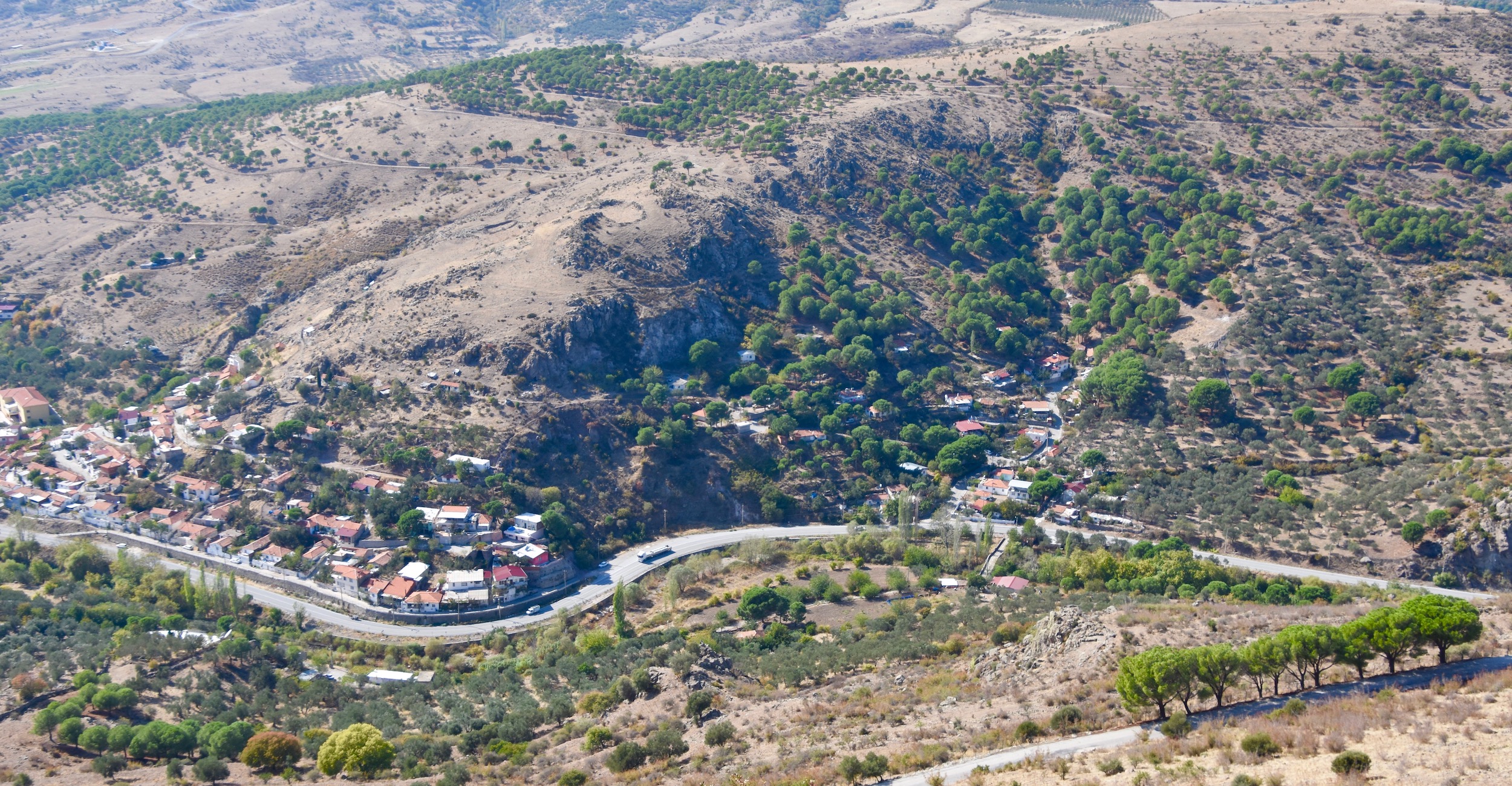
When the Germans excavated the Trajaneum they found the remnants of two great statues of Trajan and Hadrian. I don’t need to tell you where you have to go to see them today.
Yasemin then led us through the bowels of the Trajaneum to the most wondrous site at Pergamon.
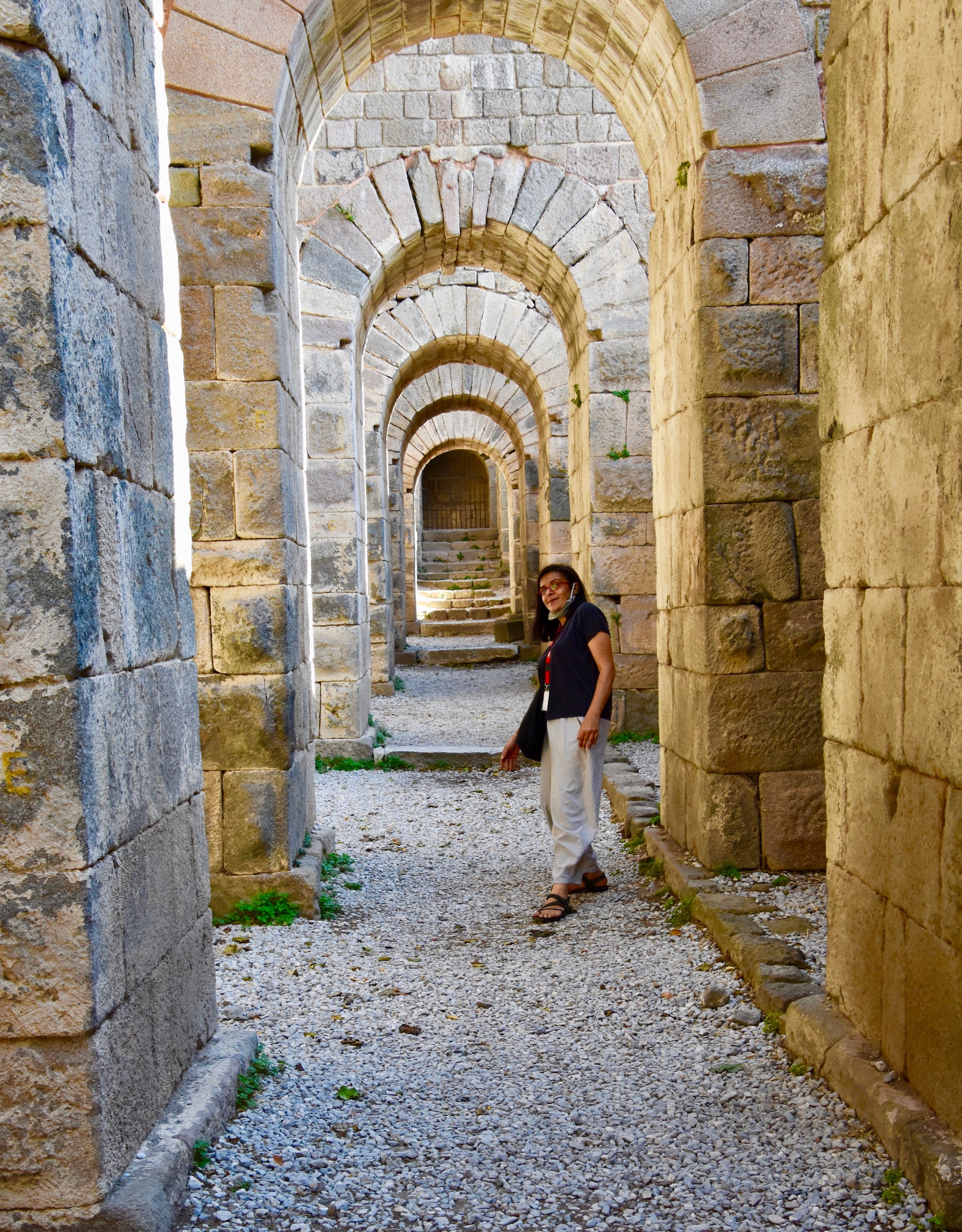
This is the Theatre of Pergamon which had seating for 10,000 spectators and was the steepest in the ancient world.
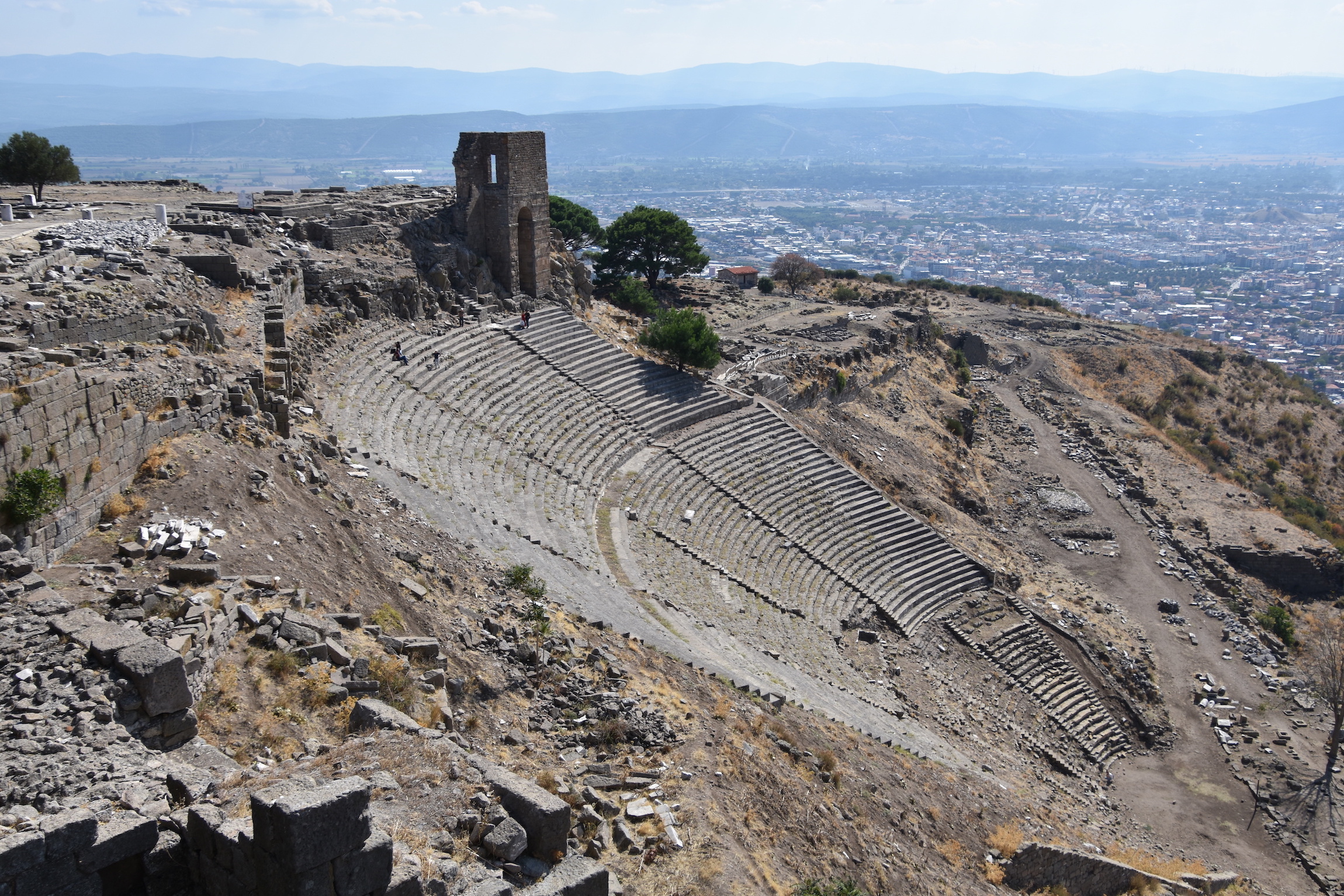
Standing at the top of the theatre can give one vertigo, but it didn’t bother Yasemin.
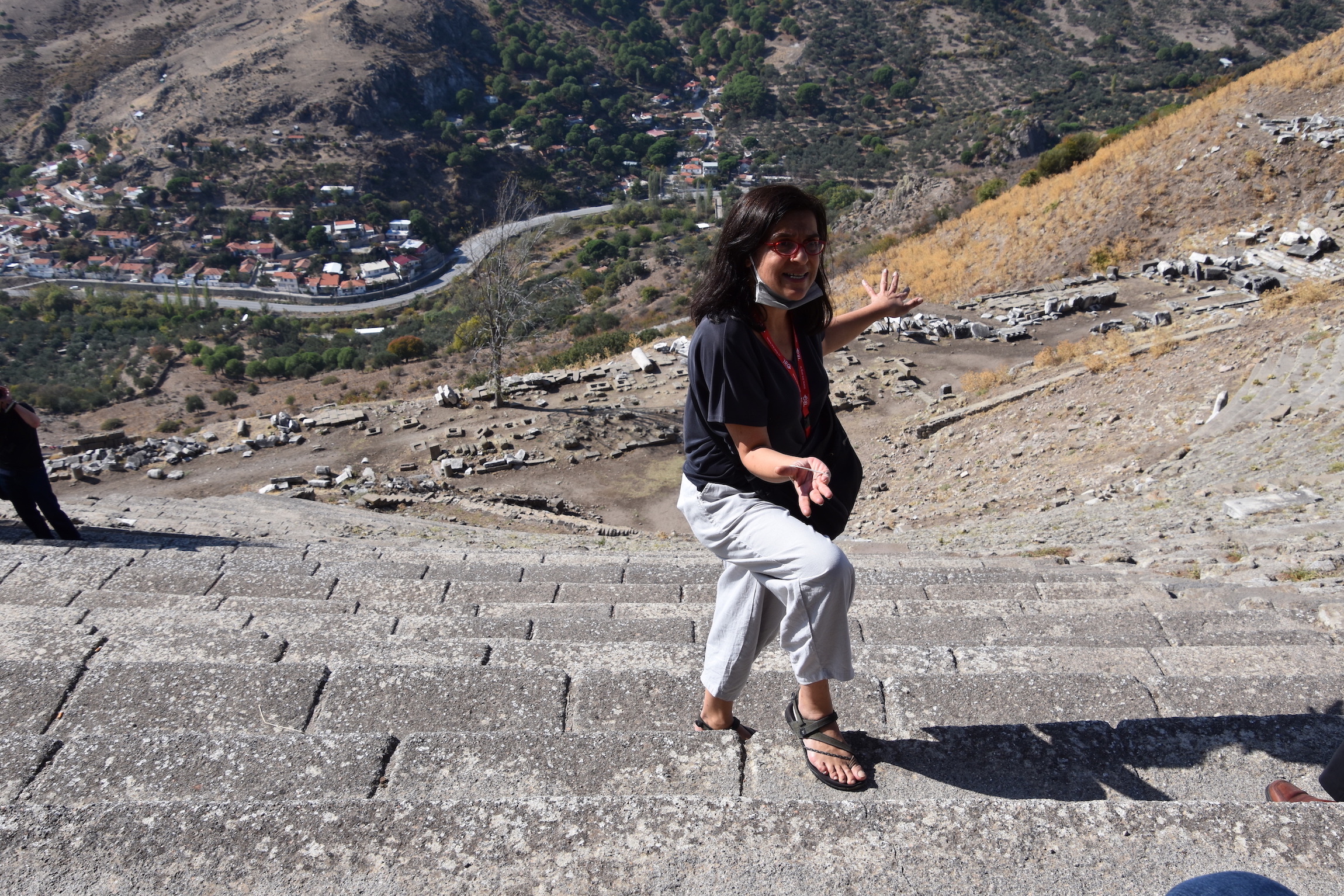
Most of our group including yours truly did descend the steps about halfway down where we veered off to see the last of the monumental sites at Pergamon.
This is all that is left of the Altar of Zeus at Pergamon, once a site famous across the ancient world.

However, the Altar has not disappeared. It is now on display at the Pergamon Museum in Berlin and looks like this. It has the second longest frieze known to exist, exceeded only by that of the Parthenon.
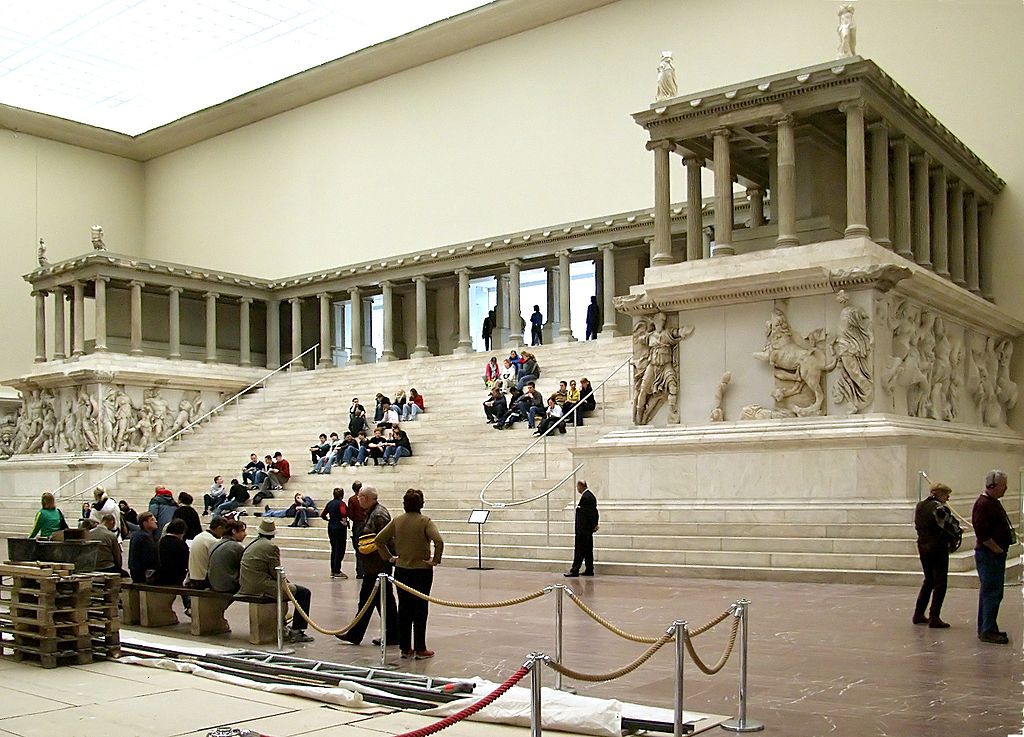
The Altar of Zeus was so famous that when John wrote the Book of Revelations he identified it as the ‘seat of Satan’. That seems fitting as Nazi architect Albert Speer used it as inspiration in building the colossal building in Nuremburg which became the focal point for the infamous rallies held there every year under Hitler’s rule.
By now I’m starting to think that I need to sign up for the next AA tour to Germany if only to see all the things the Germans removed from Turkey and the Middle East.
That concludes our visit to the ancient city of Pergamon, but not our visit to the area. Join us in the next post as we explore one of the most famous healing spots in the ancient world, the Asceplion of Pergamon.

